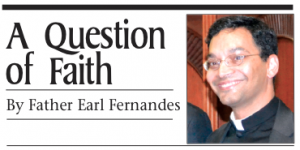Q&A: How many times did Christ rise?
Dear Father: Year after year and month after month, I have been wondering why does the creed we recite during Sunday Mass state that Christ “rose again?” When was the first time He rose? I checked my Lithuanian creed interpretation and it does not state “He rose again.” In Lithuanian, the text reads: “pagal Rasta, prisikele is numirusiu” The translation would be: pagal (according), Rasta (to the Scripture), prisikele (rose), is numirusiu (from the dead). In the Lithuanian translation there would be (ir vel) for the word “again.”
Dear Reader: Thank you for your question. It is an interesting one. I believe your Lithuanian translation is accurate and corresponds to the Greek text of the Nicene-Constantinople Creed which is recited each Sunday. In Greek, the word anastánta is used which means rising. The idea would be similar to when someone is lying down and gets up or falls off a bicycle and gets up after the fall. The word again does not really appear in Greek. Jesus rose from the dead.
I suspect you are going to a Roman Rite Church. The Creed was translated from Greek into Latin and from Latin into many languages like English. In the Latin, the text is Et resurrexit tertia die secundum scripturas. The Latin word resurrexit is used and not surrexit. One Latin scholar suggests that in resurrexit there is a compound of the prefix re and the verb surgo. “Re” might convey the idea of again, which often is a common interpretation but not the only one. “Again” in English can also mean “anew.” Jesus did not rise twice or more; He rose to life “anew.”
Commenting on this part of the Creed, Joseph Ratzinger, later Pope Benedict XVI, in his book Introduction to Christianity, wrote: “It is quite clear that after His Resurrection, Christ did not go back to His previous earthly life, as we are told the young man of Nain and Lazarus did. He rose again to definitive life, which is no longer governed by chemical and biological laws and therefore stands outside the possibility of death, in the eternity conferred by love. That is why the encounters with Him are “appearances.” That is why He with whom people had sat at table two days earlier is not recognized by His best friends and, even when recognized, remains foreign: only where He grants vision is He seen; only when He opens men’s eyes and makes their hearts open up can the countenance of the eternal love that conquers death become recognizable in our mortal world, and, in that love, the new different world, the world of Him who is to come.”
Sometime ago, another reader asked me a question about the translation of the new Roman Missal, because some of the prayers say “we may merit” or “may we merit.” Her question was: how can we merit anything? I suspect that the Latin was mereamur which could also mean, in a given context, “attain to,” but was probably translated literally as merit. The Catechism deals with the concept of “merit” (nn. 2006-2011; 2025). Article 2025: “We can have merit in God’s sight only because of God’s free plan to associate man with the work of his grace. Merit is to be ascribed in the first place to God, and secondly to man’s collaboration. Man’s merit is due to God.”
In article 2010, the Catechism states: “Since the initiative belongs to God in the order of grace, no one can merit the initial grace of forgiveness and justification at the beginning of conversion. Moved by the Holy Spirit, we can then merit for ourselves and for others the graces needed for our sanctification….”
We have to remember that much of what we read today, we read in translation from Greek and Latin, especially when we consider biblical and creedal statements. It takes time and careful study to get our minds around these “mysteries of our faith” but it is often a joy to seek the truth and to discover it.
Father Earl Fernandes is dean of Mount St. Mary’s Seminary and the Athenaeum of Ohio, where he is assistant professor of moral theology. To ask Father Earl a question about the Catholic faith, send an email to [email protected] or to The Catholic Telegraph, 100 E. Eighth St., Cincinnati, OH 45202.
This A Question of Faith column by Father Earl Fernandes originally appeared in the April 2015 print edition of The Catholic Telegraph.














